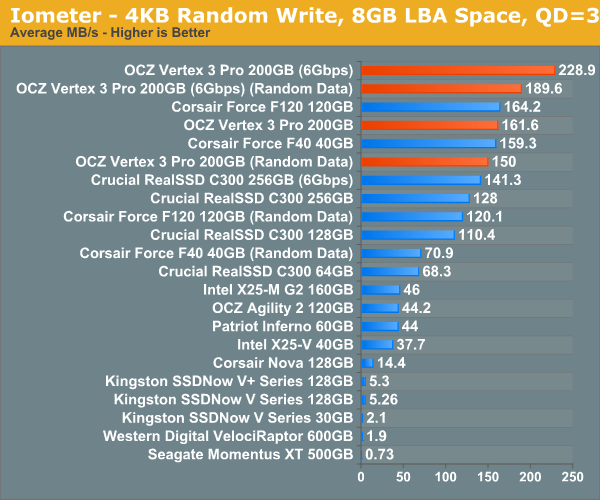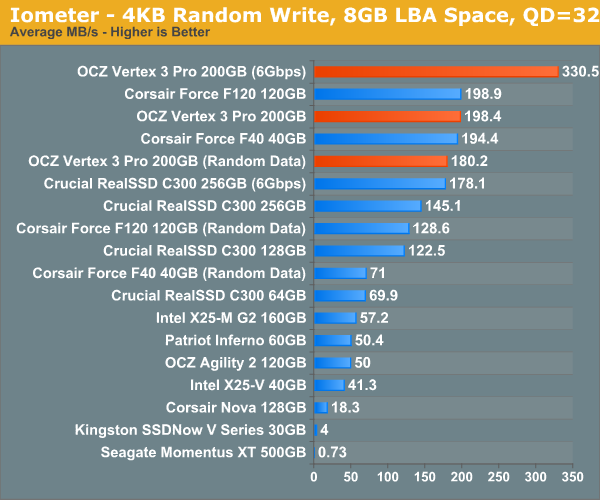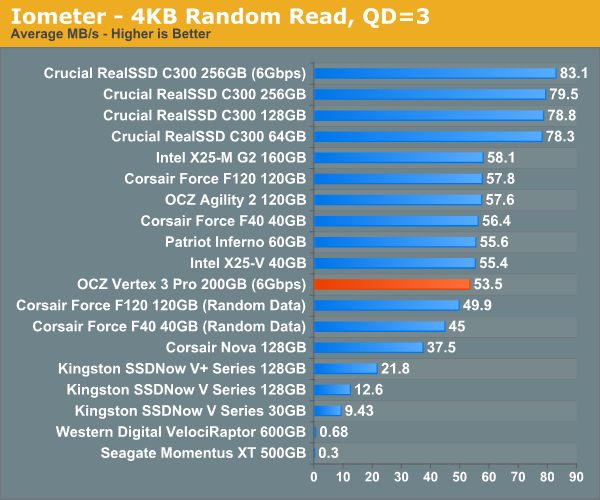OCZ Vertex 3 Pro Preview: The First SF-2500 SSD
by Anand Lal Shimpi on February 17, 2011 3:01 AM ESTThe Test
Note that I've pulled out our older results for the Kingston V+100. There were a couple of tests that had unusually high performance which I now believe was due the drive being run with a newer OS/software image than the rest of the older drives. I will be rerunning those benchmarks in the coming week.
I should also note that this is beta hardware running beta firmware. While the beta nature of the drive isn't really visible in any of our tests, I did attempt to use the Vertex 3 Pro as the primary drive in my 15-inch MacBook Pro on my trip to MWC. I did so with hopes of exposing any errors and bugs quicker than normal, and indeed I did. Under OS X on the MBP with a full image of tons of data/apps, the drive is basically unusable. I get super long read and write latency. I've already informed OCZ of the problem and I'd expect a solution before we get to final firmware. Often times actually using these drives is the only way to unmask issues like this.
| CPU |
Intel Core i7 965 running at 3.2GHz (Turbo & EIST Disabled) Intel Core i7 2600K running at 3.4GHz (Turbo & EIST Disabled) - for AT SB 2011 |
| Motherboard: |
Intel DX58SO (Intel X58) Intel H67 Motherboard |
| Chipset: |
Intel X58 + Marvell SATA 6Gbps PCIe Intel H67 |
| Chipset Drivers: |
Intel 9.1.1.1015 + Intel IMSM 8.9 Intel 9.1.1.1015 + Intel RST 10.2 |
| Memory: | Qimonda DDR3-1333 4 x 1GB (7-7-7-20) |
| Video Card: | eVGA GeForce GTX 285 |
| Video Drivers: | NVIDIA ForceWare 190.38 64-bit |
| Desktop Resolution: | 1920 x 1200 |
| OS: | Windows 7 x64 |
Random Read/Write Speed
The four corners of SSD performance are as follows: random read, random write, sequential read and sequential write speed. Random accesses are generally small in size, while sequential accesses tend to be larger and thus we have the four Iometer tests we use in all of our reviews.
Our first test writes 4KB in a completely random pattern over an 8GB space of the drive to simulate the sort of random access that you'd see on an OS drive (even this is more stressful than a normal desktop user would see). I perform three concurrent IOs and run the test for 3 minutes. The results reported are in average MB/s over the entire time. We use both standard pseudo randomly generated data for each write as well as fully random data to show you both the maximum and minimum performance offered by SandForce based drives in these tests. The average performance of SF drives will likely be somewhere in between the two values for each drive you see in the graphs. For an understanding of why this matters, read our original SandForce article.

Random write performance is much better on the SF-2500, not that it was bad to begin with on the SF-1200. In fact, the closest competitor is the SF-1200, the rest don't stand a chance.
Many of you have asked for random write performance at higher queue depths. What I have below is our 4KB random write test performed at a queue depth of 32 instead of 3. While the vast majority of desktop usage models experience queue depths of 0 - 5, higher depths are possible in heavy I/O (and multi-user) workloads:

Ramp up the queue depth and there's still tons of performance on the table. At 3Gbps the performance of the Vertex 3 Pro is actually no different than the SF-1200 based Corsair Force, the SF-2500 is made for 6Gbps controllers.











144 Comments
View All Comments
PubicTheHare - Thursday, February 17, 2011 - link
Anand,Would this be the drive to pair with a Sandy Bridge Macbook Pro, or do we still need to wait for native TRIM support in OSX?
I'm really eager to buy a Sandy Bridge MBP and do this if the V3P is the one to get. I can't recall which controller you recommended for Macs.
markjx1 - Thursday, February 17, 2011 - link
Why no mention of the fact this was originally slated for the SF-2000, and now its got the enterprise class SF-2500 with disclaimers of "hardware not final" all over the article?The truth is they had major problems with SF-2000 and nobody wants to talk about it - of all people I'd think you would have. Now go ahead and delete my post again.
markjx1 - Thursday, February 17, 2011 - link
Resorting to using the enterprise-class SF-2500 means I worry about cost competitiveness against other upcoming Gen3 offerings from Intel and Crucial/Micron.OCZ took a $25 mil bank loan recently so they need a winner. I worry about the "hardware is not final" disclaimers in the article. Sending these samples out for some buzz smells like buying time while they work out production dilemmas since originally they were going to use a different SF controller.
bplewis24 - Friday, February 18, 2011 - link
Why are you trolling? You have 3 of essentially the same posts on this page. We get it, you think he "sold out" for not mentioning that it's using a different controller.Brandon
vol7ron - Thursday, February 17, 2011 - link
Does this mean a higher QD, might improve performance.It looks like QD of 16 might be the sweet spot in terms of latency vs IOPS
DJMiggy - Thursday, February 17, 2011 - link
Thanks for the great article and thank you OCZ for making my Vertex 1 even more obsolete. That's ok though! Not a complaint! lol Just looking forward to my next upgrade!Rasterman - Thursday, February 17, 2011 - link
Since the drive is 400MB/s read, if you use two in RAID-0 are you going to get 800MB/s or the realistic max of 6gpbs of ~700MB/s?If you use RAID-0 X4 are you going to get 1600MB/s or ~700MB/s?
jwilliams4200 - Thursday, February 17, 2011 - link
With a decent RAID card, then RAID 0 of N drives will give you slightly less than N times the performance of a single drive.For on-motherboard RAID, you will also get approximately N times the performance of a single drive, but there is usually a ceiling to total performance on motherboard RAID. It is around 600 MB/s for ICHR-10.
myterrybear - Thursday, February 17, 2011 - link
I've been a loyal reader of this sight, but what realy myths me if you's use EVERY other controler but those found on the AMD platform .... especialy more so with a Sata 6.0 SSD like this it would match up well for those of us amd users whom have paid money to upgrade the motherboard to have that sb8xx controler onboard to utilize hard drives & other devices that run on the now becoming Sata 6.0 standard.Per Hansson - Thursday, February 17, 2011 - link
Hi, has the much talked about hibernation problem with the Sandforce drives been solved in the 2xxx series?Loosing Hibernation is pretty much a deal killer for me in a laptop :(
http://www.google.se/search?hl=sv&safe=off&...